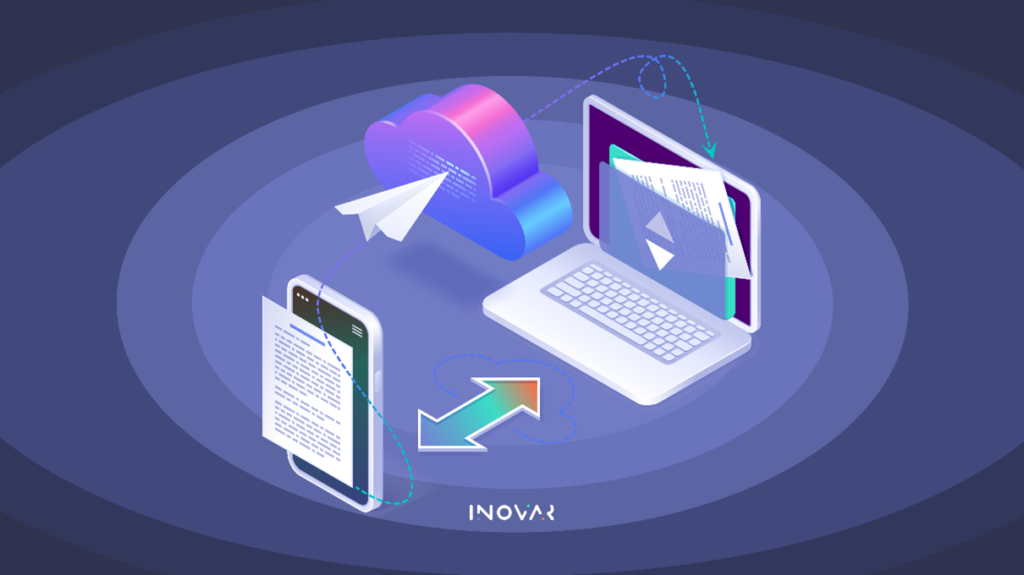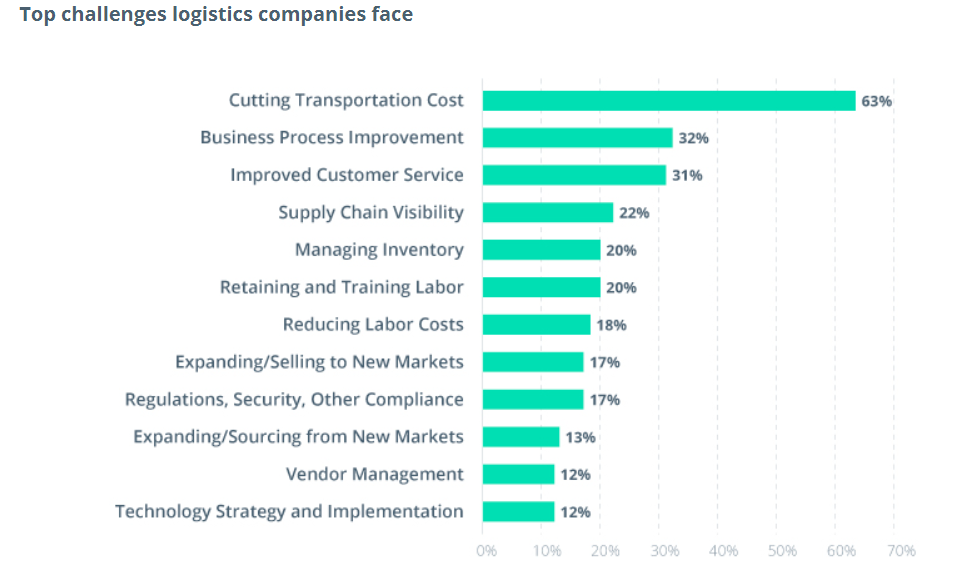Month: October 2021
SaaS or Software as a Service is making a buzz in almost every industry, and logistics is no exception. Businesses across the globe prefer SaaS-based logistics software instead of investing in developing on-premises software that might take several months or even a year to build. To understand why this shift is happening- let’s first understand what are the problems the logistics industry is facing? And how SaaS-based applications can be a perfect solution for them.
SaaS is a mechanism of transferring software to everyone (individual or business) over the internet. In this nature of software licensing and release model, the license of the software can be availed periodically. The software is centrally introduced in the cloud, and the individual, availing SaaS access through any compatible browser.

Present industry challenges:
Transportation and logistics industries are constantly struggling with challenges- like complex competition, changing customer expectations, and leveraging digitization to succeed. Lack of ‘digital culture and training is thus the biggest challenge for these companies. Attracting the right skills is one issue, but developing the right strategy is even more crucial.

Besides, an increasingly competitive environment is another dominant factor in the mix. Some of the sector’s customers are springing logistics services of their own, and different competitors to the business are shaping out more profitable aspects of the value chain by exploiting digital technology or brand-new ‘sharing’ business models. They don’t have asset-heavy balance sheets or cumbersome existing arrangements weighing them down.
There is no other industry where so many experts ascribe vast influence on data and analytics in the next five years than transportation and logistics. There are vast possibilities to enhance performance and serve customers better, and LSPs who are part of a digitally integrated value chain can benefit from significantly increased forecasting to scale up capacity or down and plan routes. Adding machine learning and artificial intelligence techniques to data analytics can deliver truly dynamic routing.
Business solutions
One of the most promising ways for transportation companies to improve their workflows and find new ideas for business growth is using a custom SaaS system. These systems guarantee more agile data processing and greater automation of operations than out-of-the-box solutions. They also allow companies to build only the features they need.
From streamlining processes to increasing visibility in the supply chain, their pertinence has grown in quality. According to Statista, 87% of logistics and supply chain firms are tapping into cloud-based solutions to facilitate transportation management and gain an edge in an ever-changing marketplace.

Businesses can optimize SaaS solutions to automate the logistics workflow and free employees from performing routine tasks connected with paperwork.
Logistics is a sphere of multitasking and multiprocessing. Robust SaaS solutions are essential for tracking details and conducting analysis, which helps businesses detect issues and optimize their work. They are designed to simplify and manage complicated logistics problems by taking an integrated, end-to-end approach. The functionality enables optimal route planning, reductions in fuel costs, and significant improvements in asset utilization
.

Logistics companies gain real-time visibility from SaaS solutions into logistics processes and data, assisting businesses to keep their operations under command. SaaS logistics solutions support companies to reach a more predictable supply chain, while companies can associate in the cloud to cooperate efficiently.
SaaS solutions empower operators to access high-level route planning abilities on demand, encouraging them to avoid the high capital cost investment and the in-house IT staffing required for superior systems integration. We can directly scale them up or down according to business needs without infrastructure changes as they are delivered as a service.
Inovar optimized SaaS solution for logistics
Inovar joined hands with fleet operators to manage their logistics operations and apply technology for making their workflow automated. With an AI-powered SaaS solution, we gave fleet operators ways to predict demand, optimize vehicle usage, and give them real-time tracking of their vehicles from both fleet operators and consumers.
Our first aim was to bring all stakeholders Markets, Warehouses, Traders, Ports, and Truckers under a single virtual platform and allow them to trade on-demand within an open marketplace.
Inovar brought Microsoft Azure IoT and machine learning services within a customized application that could build a connected platform for fleet operators. The solution could not only gather data efficiently but generate intelligence as it was used. Another remarkable feature was analytics and event hubs that captured data used in a Databricks platform to generate insights. Using these insights, system booking, scheduling, predictive maintenance cycles became 70% easier than before.
Finally, the system went live with 1000+ vehicles, and the logistics client started to reap ROI from multiple avenues. Within 3 months, the efficiency of their operations improved by 30% with better security, high scalability, and faster availability from the end-user.
Summing up, we can say that cloud logistics automation is beneficial to all participants in the supply chain. It allows you to easily solve complex problems, so its popularity will only grow every year. As a logistics software development partner, we solve many standard and custom needs of the transportation industry from Business as well as Technology perspectives. After many years spent in the logistics domain, our dedicated development team learned specific details and gained experience that can be used to effectively help you with any of your logistics software that you need to develop.
InovarTech is ready to improve your automation experience. With our brilliant forms and streamlined workflows, you will be fit to tackle process technologies and know-how to adapt them to your institution. Reach out to us today to get started. You can take comfort because we know process automation and how to implement them effectively. Let us deliver high-volume processes to your doorstep.
The pandemic has changed how people around the world live, work, and engage with each other. In late 2019 when covid-19 struck the world, affecting millions of people all over the planet — the healthcare industry was hit the most. The pressing need for resources, information, cost optimization, and supply chain inefficiencies in the sector calls for a major technology overhaul. Therefore, embracing new-age digital technologies is key for healthcare providers in addressing the immediate concerns and driving long-term goals.
Automation makes a revolutionary process change in most of the industries, that has the same or even more potential for the healthcare sector. Introduction of Business Process automation can streamline the healthcare system for simplicity, increase service quality, and manage pen and paper-based manual tasks, saving time and cost without the slightest glitch.
Challenges in Healthcare
Application Disparity: Modern healthcare is a complex environment where many disparate applications work. The complexities also grow with the business. With mergers and acquisitions, modern technologies are adopted to meet new challenges. In this situation managing all technology becomes quite difficult for the healthcare IT departments and business users.
For example, in most healthcare sectors, patient data transfer is still carried out manually in the form of files and documents from one department to another. As the volumes of data are generally high, compiling them in one single process is a tedious and lengthy process. Not to forget, since they are done manually, there is always scope for multiple human errors and miscalculations. The greater the rate of error, the more the cost will be for rectification.
Lack of efficiency in patient service is another challenge that can be a barrier to your organization’s growth and reputation. In most scenarios, customer care executives are busy with paper works and other files and documents compilation that they lack prompt and timely delivery of services to the customers.
I hope you can relate to the problems I discussed above. So now I am going to share how automation becomes an integral part to solve some of healthcare challenges.
The business automation software works on all programs whether, new applications, legacy programs, cloud-based solutions, or on-prem.
BPA makes human-oriented processes much smoother with greater results like increased speed, productivity, and efficiency. Suppose for a patient, scheduling an appointment with a doctor usually happens online in a matter of minutes, but what happens behind the scenes is a bit more complicated. Healthcare institutions have to collect personal information, diagnosis, insurance details, and confirm the doctor’s availability. If the right information cannot be accessed during the registration process, or if the doctor is not available, it is up to the staff to inform the patient beforehand.

Implementing automation can resolve some of the bottlenecks related to scheduling patient appointments. Bots can automate patient data collection and processing, so patients can be optimally scheduled according to diagnosis, location, doctor availability, and other criteria. By simplifying appointment scheduling, healthcare institutions can focus their efforts on providing exceptional service and other tasks that cannot be automated. Automation tools also enable customer care executives to take the assistance of such tools with automated call and email options.
Inovar proposed Automation Solutions with better ROI
Something similar also happened with one of our US healthcare clients. They were also facing customer support challenges during the pandemic. They were primarily using a pen and paper-based system for information collection and symptom analysis. After the outbreak of the virus, a lot of patients started asking for support in their chatbot regarding diagnosis, vaccination, and other medical support.
With a lot of restrictions, it becomes necessary to give patients the capability to run the assessments on their own from the comfort of their homes. Remote work capability also became especially important, and they needed an infrastructure through which they can achieve that.

To manage the entire scenario, they required VPN, which was not designed for such large-scale use resulting in low bandwidth and frequent outages. Additionally, a lot of the content and manual workflows required the physical presence of the employees on the hospital premises that was quite impossible at that moment.
In this critical situation, the first hurdle to cross was to get them to a cloud-based solution to ride care facilities across all their nation-level operations and provide the best health support to patients. This would make remote work possible for the hospital staff in case they were showing symptoms and had to quarantine at home.
In this situation, Inovar helped a leading US healthcare organization to automate their Covid-19 Helpdesk and Registration process from a pen and paper-based manual system to a cloud-based automated solution.
SharePoint Online became the choice of the platform along with Power Platform as their primary productivity technologies allowed them to create a technology framework with a built-in rapid growth mechanism and assist hospital staff to manage the entire remote work process.
With the implementation of the initial solution, the healthcare organization was also facing challenges to roll out the solution in all other locations of the US that becomes much fair with SharePoint and the power platform.

A simple but practical experience gained a high adoption rate within the healthcare organization. The organization’s IT team also considered it as the best rollout experience with almost a zero-touch provisioning and deployment strategy. Ultimately, with all these solutions 90% of their remote and quarantined caregivers were able to serve the patients over remote calls and Online consultation.
The digitization of call centers was a major bonus as it consisted of Automated Diagnosis for Covid, automatic decision-making capabilities, and other similar tools that ensured self-help services that were non-existent before. This resulted in a reduction of 70% in phone calls.
Businesses transitioning from manual processes to comprehensive workload automation tend to go through several phases on their automation journey. If you are also facing the same difficulties within your organization, then Inovar is the best partner to collaborate with and make your automation journey smoother. Feel free to reach out to us we would love to collaborate!